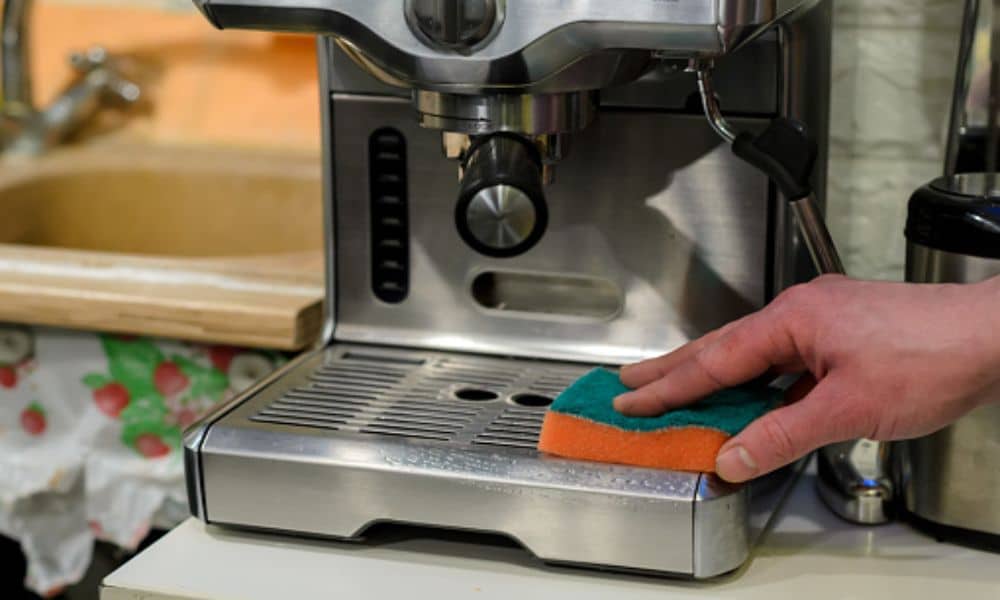I used to clean my coffee maker with vinegar. It worked, but the sour smell never went away. My coffee started to taste odd—like a hint of vinegar in every sip! That’s when I looked for how to clean the coffee maker without vinegar.
I tried a few simple things—baking soda, lemon juice, and even a bit of dish soap. They worked better than I hoped. No smell, no bitter taste, just clean coffee and a fresh start every morning.
Now, I’ll show you the easy steps to clean your coffee maker the same way I do. You don’t need fancy tools or strong cleaners. Just a few kitchen staples and a few minutes—and your coffee pot will shine again.
Why You Might Want to Avoid Vinegar
Many people clean a coffee maker with vinegar because it works fast. But vinegar can leave a strong smell that stays in the machine. Even after rinsing, that sharp scent can hang around. When you brew again, the taste feels off—like sour coffee.
Short answer: Avoid vinegar if you hate that sour smell or odd taste after cleaning.
I learned this myself. The first time I used vinegar, my kitchen smelled like a jar of pickles. My next cup of coffee had a strange tang I couldn’t ignore. That was when I looked for how to clean the coffee maker without vinegar and found better ways.
Vinegar does remove buildup, but it seeps into small parts that trap odor. Over time, it can even dry rubber seals or leave a film that changes flavor. Using vinegar too often may harm your machine and ruin your brew.
If your coffee tastes funny after cleaning, vinegar is often the cause. Try baking soda, lemon juice, or a little dish soap instead. They clean well and leave no bad smell behind. Cleaning your coffee maker without vinegar keeps your coffee pure and your mornings fresh.
Why You Might Want to Avoid Vinegar
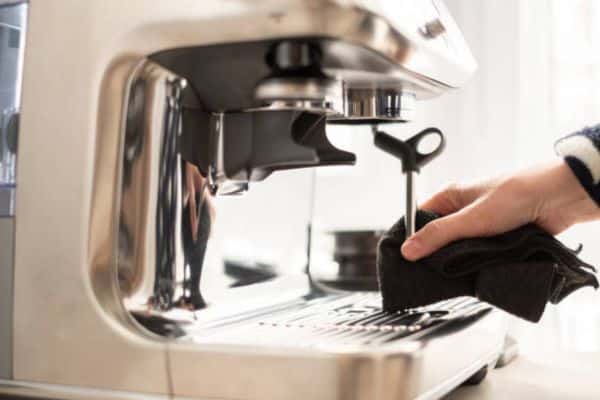
Many people use vinegar to clean their coffee makers. It works well but leaves a strong odor that lingers. That sour trace often seeps into the next brew. The taste turns dull, losing the rich flavor of fresh coffee.
The smell can spread through the kitchen and stay for hours. Even after several rinse cycles, the sharp scent remains. A faint tang may cling to the cup and spoil the aroma. This single issue makes many home brewers switch to gentle cleaners.
Vinegar also reaches small seals and tubes inside the machine. The acid can dry those parts over time and cause wear. A cleaner that harms the hardware never feels worth the trouble. A mild solution keeps both flavor and machine safe.
Simple ingredients like baking soda, lemon juice, or dish soap work better. They clear buildup, remove stains, and leave no heavy scent behind. A fresh cup brewed afterward tastes pure and clean. That small change makes every morning brighter.
What You’ll Need Instead (Simple Household Alternatives)
A few simple ingredients can keep your coffee maker spotless and fresh. They work gently, clean deeply, and leave no harsh scent behind. Each one brings a unique benefit that suits daily cleaning.
- Baking soda – A natural deodorizer that breaks down stains and oil. It softens buildup and clears residue from the water lines.
- Lemon juice – A mild acid with a bright, clean scent. It fights mineral scale and leaves the carafe smelling fresh.
- Dish soap – A reliable cleaner for the carafe, filter basket, and drip tray. It cuts grease without harming the surface.
- Hydrogen peroxide – A light sanitizer that removes hidden grime. Use in small amounts for deep cleaning.
- Cream of tartar – A gentle descaler that lifts stubborn marks and restores shine.
All these options work beautifully for anyone avoiding vinegar. They clean as effectively and keep the coffee flavor pure. A clean machine means a smoother brew and a happier morning.
Step-by-Step – How to Clean the Coffee Maker Without Vinegar
A spotless coffee maker makes every cup taste bright and smooth. These simple methods utilise gentle, household ingredients that work quickly and leave no harsh odour. Each one keeps the flavor pure and the machine running strong.
01. Baking Soda Method
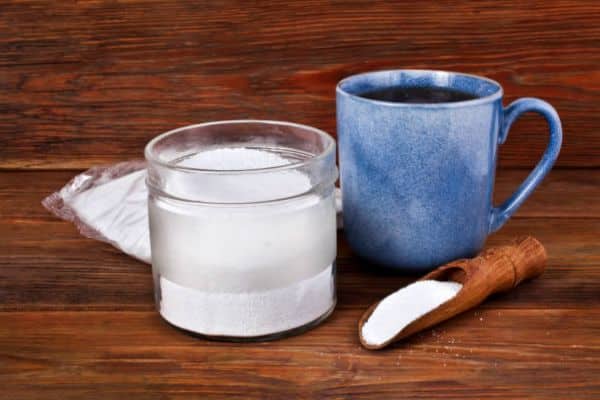
Mix one-fourth cup of baking soda with one cup of warm water. Pour the mix into the reservoir and start a full brew cycle. Follow with two cycles of clean water to rinse away any residue. This method clears buildup and removes oily film that dulls the flavor. Baking soda also neutralizes odors, leaving a light, clean scent that never overpowers your next brew.
02. Lemon Juice Method
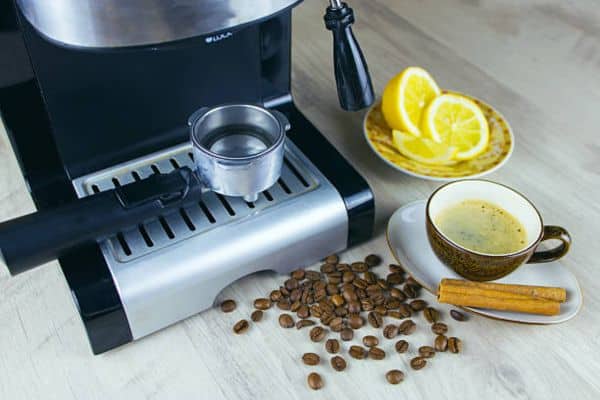
Combine equal parts lemon juice and water. Pour the mix into the tank and start a normal brew cycle. Run two fresh-water cycles right after for a complete rinse. Lemon juice acts as a mild acid that breaks down mineral scale naturally. The fresh citrus aroma replaces that heavy smell of vinegar and gives the carafe a pleasant, clean finish. A quick run with lemon juice keeps the coffee tasting crisp and bright.
03. Dish Soap Method (for Carafe & Removable Parts)
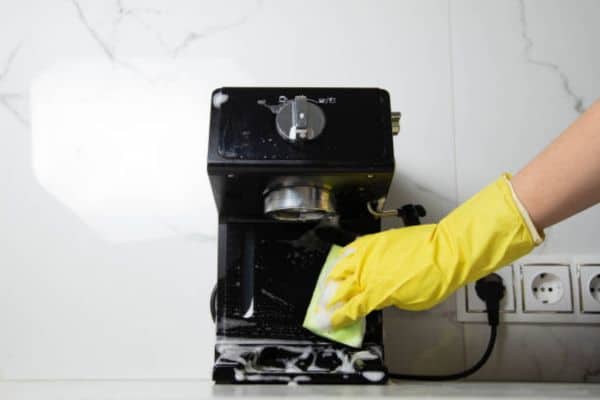
Remove the carafe, filter basket, and drip tray. Soak them in warm, soapy water for a few minutes. Use a soft sponge to scrub away grease and stains, then rinse well and let them air-dry. Dish soap cuts through leftover oil and coffee stains with ease. It restores shine to glass and metal parts without leaving residue. A clean carafe and basket mean smoother pours and a richer aroma in every cup.
Descaling Without Vinegar – Deep Cleaning Tips
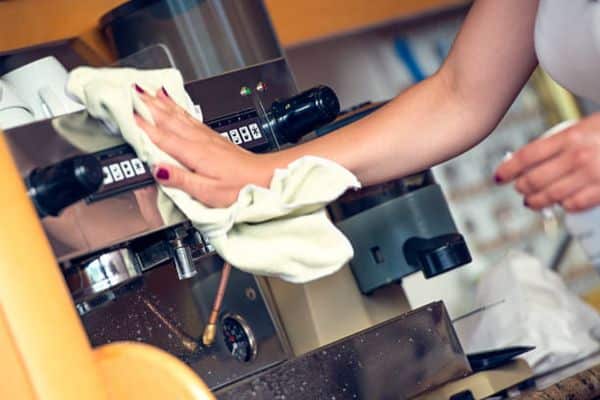
Hard water leaves tiny mineral spots inside the coffee maker. Over time, those layers block the flow and dull the flavor. A quick descale clears the system and brings back that fresh taste. Regular care keeps the brew smooth and the heat even.
Natural cleaners handle this job well. Citric acid, baking soda, and lemon juice each break down buildup safely. Citric acid clears calcium, baking soda softens grime, and lemon juice brightens the metal parts. They clean deep without harsh smell or wear. Natural products remove scale gently and protect the flavor of every cup.
Mix one tablespoon of citric acid with a full tank of water. Start a full brew, then rinse twice with clean water. The same method works with baking soda or lemon juice. Using these ingredients restores the water path and boosts machine performance.
This simple process suits Ninja, Keurig, and Mr. Coffee machines. Each stays in better shape with mild descaling instead of strong chemicals. Gentle cleaning keeps the seals tight, the heater strong, and the taste bold.
How to Clean Specific Coffee Makers (Quick Reference)
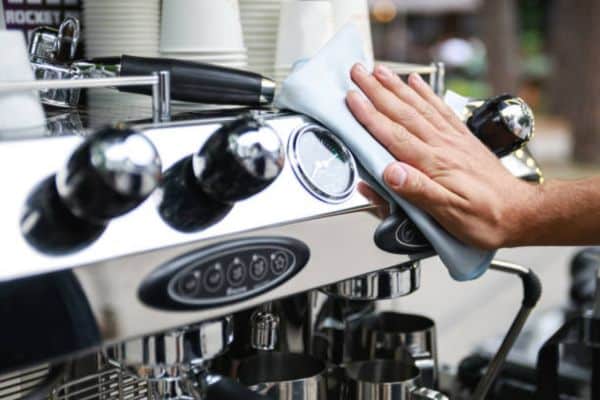
Each coffee maker needs a slightly different touch. The goal stays the same—a clean system and a better brew. These quick methods work fast and keep your machine running smooth.
Cleaning a Ninja Coffee Maker Without Vinegar
Mix equal parts lemon juice and water or use a light baking soda mix. Pour the solution into the reservoir and start the built-in clean cycle. Rinse twice with plain water for a pure, fresh finish.
Lemon juice removes scale while baking soda clears oil and residue. Both leave the machine bright inside and free from odor. Using lemon juice or baking soda is the best way to clean a Ninja coffee maker without vinegar while keeping the flavor rich and smooth.
Cleaning a Drip Coffee Maker or Coffee Pot
Fill the carafe with warm water, add one tablespoon of baking soda, and a drop of dish soap. Let it sit for ten minutes, then scrub gently with a sponge. Rinse the pot well and run one plain-water brew to clear any remaining traces.
This light method lifts coffee stains and oily buildup with ease. It keeps the glass clear and the coffee fresh. A baking soda and dish soap soak works better than harsh vinegar and leaves no sour scent behind.
Extra Tips for Keeping Your Coffee Maker Fresh Longer
A few small habits make a big difference in taste and performance. A clean coffee maker lasts longer and keeps every brew bold and smooth. Simple care saves time and protects the flavor you love.
Empty used grounds right after brewing to stop buildup. Damp grounds hold odor and create stains that spoil the next cup. Clearing the basket right away keeps your coffee fresh and your maker clean.
Wipe the exterior each day with a soft cloth. A quick wipe removes splashes and oil from brewing. The machine stays bright and looks new. Daily care keeps the surface clean and stops grime from setting in.
Plan a deep clean every two weeks for steady flavor. Mineral film builds slowly inside the tank and lines. A gentle wash with baking soda or lemon juice clears it fast. Regular deep cleaning keeps the flow strong and the taste rich.
Use filtered water to lower mineral deposits. Hard water leaves scale that slows heat transfer. Soft water gives a smoother brew and helps the parts last. Filtered water protects your coffee maker and improves each sip.
Final Thoughts
No vinegar? No problem! A few simple ingredients can keep your coffee maker spotless. Baking soda, lemon juice, and mild dish soap do the job perfectly. Each one clears buildup, removes odor, and keeps the flavor pure. Natural cleaners make the coffee maker shine and the coffee taste better.
After switching to baking soda and lemon juice, my coffee turned brighter and smoother. The bitter edge disappeared, and the aroma felt new again. A clean machine always rewards you with a richer cup. Fresh care brings out the best taste every morning.

